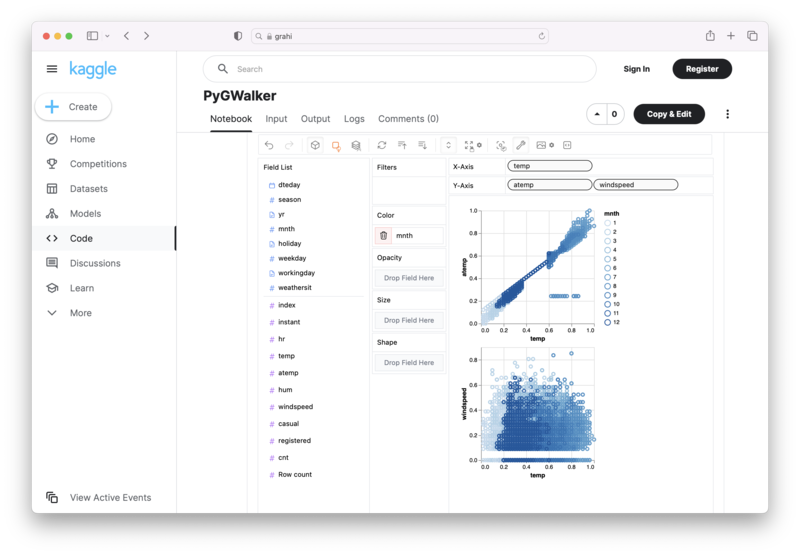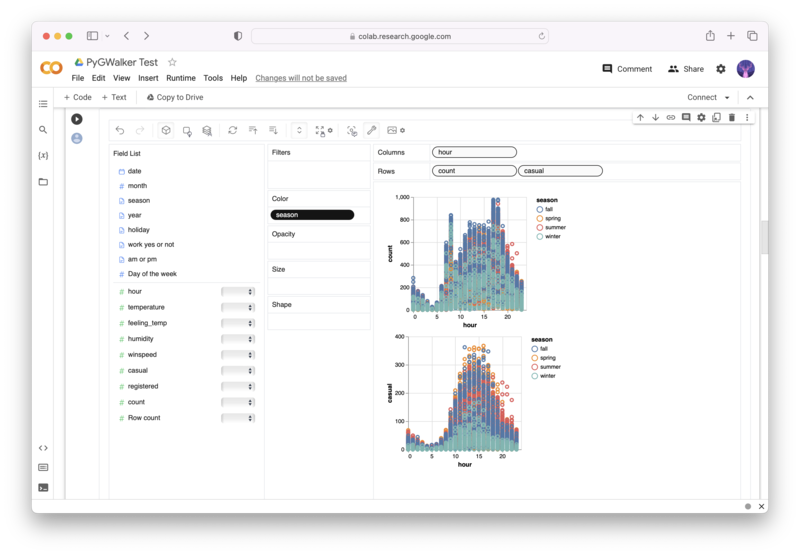How to Create Empty DataFrame in Pandas
Published on
As a data scientist, working with datasets is a daily affair. The dataset could be in the form of a CSV (Comma Separated Values) file, JSON (JavaScript Object Notation) file, SQL (Structured Query Language) database, or an external API (Application Programming Interface). Once we have the dataset, we need to work on it to extract patterns and insights. To do this, we use various tools and libraries, one of which is Pandas.
Pandas is a widely used Python library for data manipulation and analysis. It provides an easy-to-use interface for data cleaning, transformation, and visualization. DataFrame, Series, and Index are the main components of Pandas. In this article, we will focus on DataFrame and learn how to create an empty DataFrame in Pandas.
Want to quickly create Data Visualizations in Python?
PyGWalker is an Open Source Python Project that can help speed up the data analysis and visualization workflow directly within a Jupyter Notebook-based environments.
PyGWalker (opens in a new tab) turns your Pandas Dataframe (or Polars Dataframe) into a visual UI where you can drag and drop variables to create graphs with ease. Simply use the following code:
pip install pygwalker
import pygwalker as pyg
gwalker = pyg.walk(df)You can run PyGWalker right now with these online notebooks:
And, don't forget to give us a ⭐️ on GitHub!
What is DataFrame?
A DataFrame is a two-dimensional labeled data structure with columns of potentially different types. It is similar to a spreadsheet or SQL table, where data is organized in a tabular format. It consists of rows and columns, where each row represents a record and each column represents a feature or attribute of that record. A DataFrame is a versatile data structure that can hold various types of data, including integers, floats, strings, and even other Pandas data structures. You can perform operations on a DataFrame, such as filtering, slicing, joining, and aggregation.
Why do we need an Empty DataFrame?
An empty DataFrame is a DataFrame with no rows and no columns. It is sometimes useful to create an empty DataFrame and then populate it later with data or append data to it. For example, if we want to store data on different products into a DataFrame, we can create an empty DataFrame with columns such as ProductID, ProductName, ProductDescription, Price, etc., and then fill it with data from different sources.
How to create an Empty DataFrame?
There are various ways to create an empty DataFrame in Pandas. Here we will cover three methods:
Method 1: Using the DataFrame() Constructor
The easiest way to create an empty DataFrame is to use the DataFrame() constructor. This constructor returns an empty DataFrame with no columns and no rows. Here is an example:
import pandas as pd
df = pd.DataFrame()
print(df)Output:
Empty DataFrame
Columns: []
Index: []We can see that the DataFrame df has no columns and no rows. To add columns, we can simply assign a list of column names to df.columns. For example:
df.columns = ['ProductID', 'ProductName', 'ProductDescription', 'Price']
print(df)Output:
Empty DataFrame
Columns: [ProductID, ProductName, ProductDescription, Price]
Index: []Now, we have created an empty DataFrame with four columns.
Method 2: Using the dict() Constructor
The second method to create an empty DataFrame is to use the dict() constructor. This method creates an empty dictionary and then converts it to a DataFrame. Here is an example:
import pandas as pd
data = dict(ProductID=[], ProductName=[], ProductDescription=[], Price=[])
df = pd.DataFrame(data)
print(df)Output:
Empty DataFrame
Columns: [ProductID, ProductName, ProductDescription, Price]
Index: []Like in the previous method, we can add columns by assigning a list of column names to df.columns.
Method 3: Using the from_dict() Method
The third method to create an empty DataFrame is to use the from_dict() method. This method creates a DataFrame from a dictionary of empty lists. Here is an example:
import pandas as pd
data = {'ProductID': [], 'ProductName': [], 'ProductDescription': [], 'Price': []}
df = pd.DataFrame.from_dict(data)
print(df)Output:
Empty DataFrame
Columns: [ProductID, ProductName, ProductDescription, Price]
Index: []Again, we can add columns by assigning a list of column names to df.columns.
How to check if a DataFrame is empty?
Sometimes we may want to check if a DataFrame is empty or not. We can do this by using the empty attribute of a DataFrame. This attribute returns True if the DataFrame is empty; otherwise, it returns False. Here is an example:
import pandas as pd
data = {'ProductID': [1, 2, 3], 'ProductName': ['A', 'B', 'C'], 'ProductDescription': ['Desc1', 'Desc2', 'Desc3'], 'Price': [10.0, 20.0, 30.0]}
df = pd.DataFrame(data)
print(df.empty) # False
empty_df = pd.DataFrame()
print(empty_df.empty) # TrueOutput:
False
TrueIn this example, we first create a DataFrame df with some data. We then use the empty attribute to check if it is empty or not. As df has some data, df.empty returns False.
We then create an empty DataFrame empty_df using the first method, and again, we check if it is empty using the empty attribute, which returns True.
Conclusion
Creating an empty DataFrame is a common operation in data analysis. In this article, we have learned how to create an empty DataFrame using various methods in Pandas. We have also learned how to check if a DataFrame is empty or not. Now, you can start experimenting with Pandas DataFrames and improve your data analysis skills.


